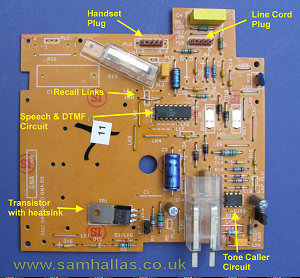

Sam Hallas' Website
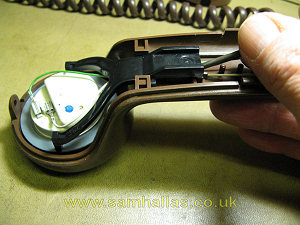
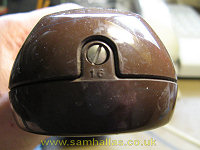
The handset is held together by the single screw at the earpiece end - the only other screw in the entire telephone - and two pegs at the cord end. The mouldings snap together along all edges. By applying a little leverage at the cord end the two sections can be pulled apart.
The transmitter and receiver inserts are held in by plastic clips which lock into ridges in the handset moulding. They can be removed by levering the clip upwards at the end nearest the centre and pushing towards the centre (see picture below). The picture can only show the levering part, as I only have two hands and one was holding the camera.
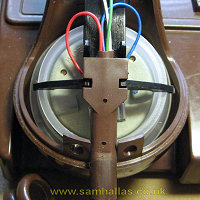
Another cunning bit of design is the way the cord grommet is held in place by the transmitter insert clip (right).
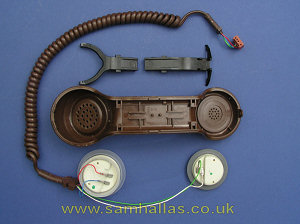
Here’s what the handset looks like with the inserts removed (left). The transmitter is a dynamic capsule, rather than a carbon microphone, made possible by the use of semiconductor transmission circuitry.

The circuit board is a single-sided board, as evidenced by the number of bridging links. Multi-layer boards are essential for high-speed digital boards, but in this application a single-sided board is the most economical choice. The regular North-South and East-West alignment of components indicates that the board is designed for automatic component placing.
The integrated circuits require a minimum of support keeping the overall component count low. The upper IC provides speech circuits and DTMF signalling. The smaller IC is the tone caller circuit. The only other semiconductors are the power transistor, to control line current, and a number of diodes.
The board as fitted contains a number of unused features of which I am not aware. There are two link selectable options. Marked towards the top are the links LKH and LKJ which select timed-break or earth recall. Beneath the integrated circuit IC1 are LKF and LKG, of unknown function.
The Statesman probably represents the pinnacle of British telephone production design for economical manufacture. It combines clever mechanical design with a minimum number of individual parts with, for the time, state of the art electrical design. Low component count and automated assembly made it worthy of its title as the IneXpensive Telephone, IXT.
Although this was nearly the era of the throw-away telephone, a large number of telephones were still rented from the network provider. For this reason the Statesman was also designed to have the most common faults repaired. The case fixing screw mates with a metal threaded insert meaning the case can be opened many times without damage - unlike cases held with self-threading screws which wear out very quickly. The handset and line cord, being the most prone to faults are plug-replaceable.
 Previous
Project Title Page
Previous
Project Title Page 